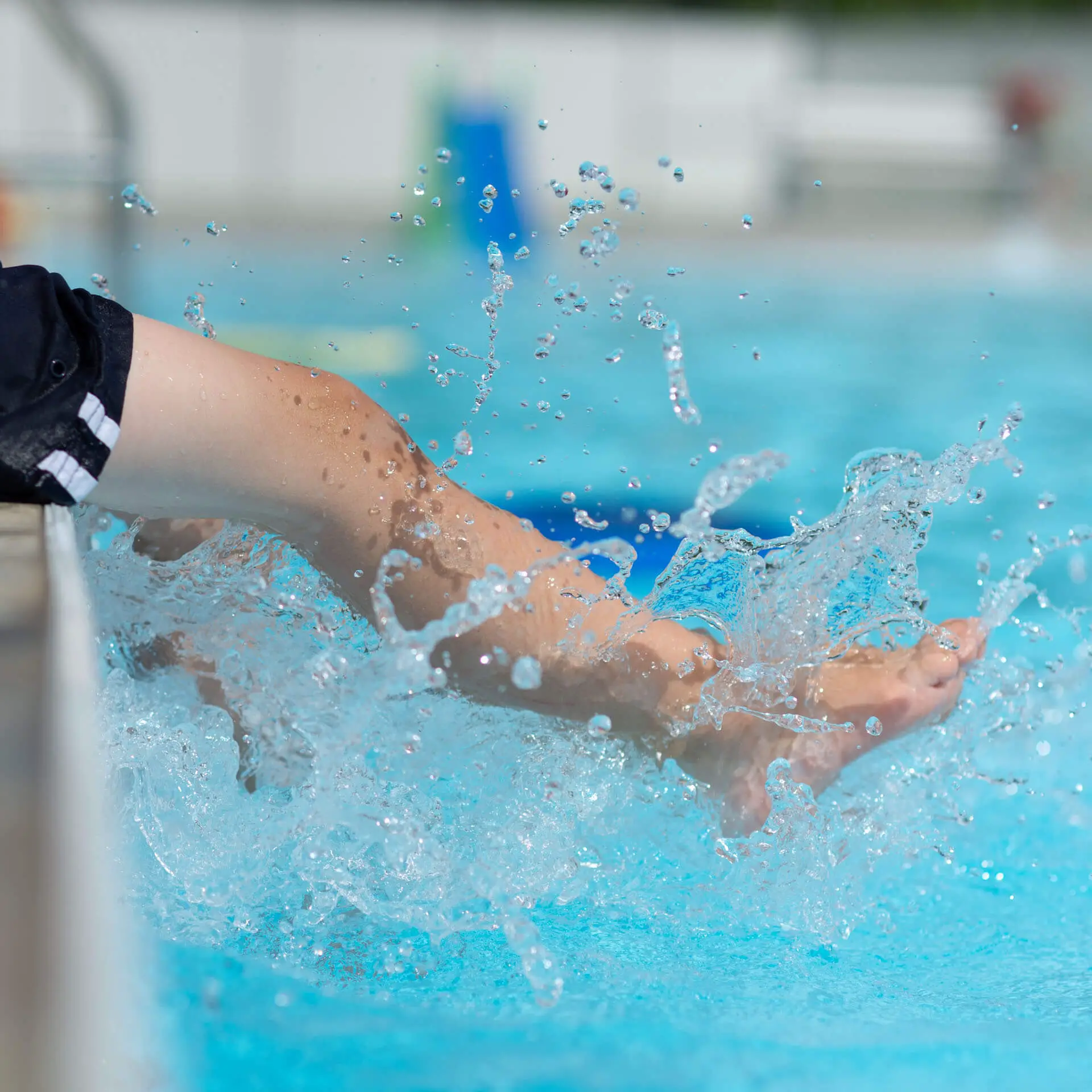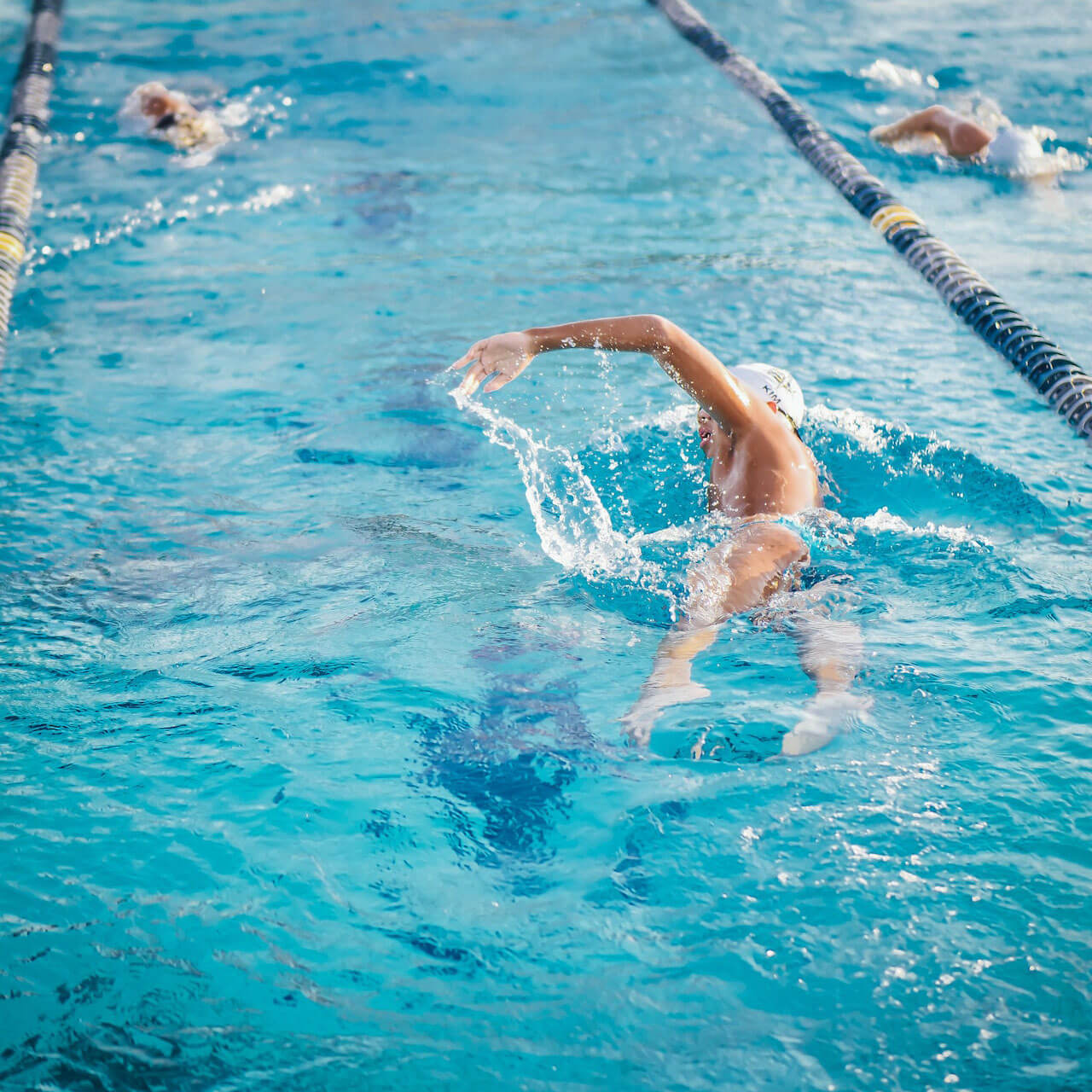Swimming is often considered a low-impact exercise that puts minimal strain on joints and muscles, making it an ideal workout for people recovering from injuries or experiencing joint pain. However, certain aspects of swimming can still contribute to the development of shin splints.

Repeatedly kicking off the walls at each turn while swimming may cause shin splints, though it is unlikely. Chances are, the real culprits are walking, running, or jumping, and you just happened to notice your shin splint while swimming. To alleviate the pain, remember to rest, ice, compress, and elevate your injury. Also consider wearing orthotic supports.
In this article, we’ll dig deeper into the causes of shin splints, how swimming could potentially trigger them, and what you can do to prevent and alleviate discomfort.
Understanding Shin Splints
Medial Tibial Stress Syndrome
Shin splints, also known as medial tibial stress syndrome, refer to pain along the shin bone (tibia) in the front of your lower leg.
This pain is often a result of intense or recently increased physical activity. It’s common among runners, dancers, and military recruits but can occur in anyone who frequently puts stress on their legs.
Tibia and Shinbone
The tibia, commonly known as the shinbone, is the large bone on the front of your lower leg.
When you experience shin splints, the muscles and bones in this area, as well as the connective tissues, are strained, causing inflammation and pain.
To prevent shin splints and maintain a healthy exercise routine, consider these tips:
- Gradually increase the intensity of your swimming workouts, allowing your body to adjust
- Invest in proper footwear with good arch support and cushioning for use outside of the pool
- Strengthen your calves and other leg muscles to better support the tibia
- Add cross-training activities, such as cycling or rowing, to reduce strain on your shins
- Practice proper exercise techniques and form, especially when kicking off the wall at each turn
By understanding the factors that contribute to shin splints and the connection to your tibia and shinbone, you can take steps to prevent this painful condition from occurring while maintaining an active lifestyle.
Shin Splints and Swimming

How Swimming May Cause Shin Splints
Shin splints, or medial tibial stress syndrome, are often caused by an imbalance between the muscles that lift the foot and those that pull it down. This can happen during activities like running, dancing, and even swimming.
During swimming, you will use your calf muscles to push off the wall during turns or to perform a strong kick. This excessive use of your calf muscles can lead to stress on the muscle and the bone, which could potentially cause shin splints.
Additionally, improper footwear or training on hard surfaces during dryland training can increase your risk of developing this painful condition.
However, developing shin splints from swimming alone is less common and is often associated with additional high-impact exercises in your routine. The cause of your shin splints probably occurred outside of the pool.
Alternative Low-Impact Exercises
If you’re dealing with shin splints or trying to avoid the risk, there are other alternative low-impact exercises to consider.
These activities can provide relief while still allowing you to maintain your fitness level. Some alternatives include:
- Biking or Cycling: Both activities are low-impact and don’t put as much stress on your shins as running or walking, making them a great option for anyone dealing with shin splints.
- Elliptical Machine: This machine simulates walking or running but without the impact on your joints, making it easier on your shins.
- Water Aerobics: If you still want to enjoy the benefits of water-based exercise, water aerobics provides aerobic activity without the stress on your shins.
Incorporating these low-impact exercises into your routine can help you maintain your fitness level while giving your shins the necessary time to heal or prevent injury..
Treatment Options
Rest, Ice, Compress and Elevate (RICE)
When you have shin splints, the best thing you can do is to give your body a break. Resting and avoiding activities that cause pain or discomfort will allow your muscles and bones to heal properly.
To reduce inflammation and alleviate pain, apply ice packs on your shins for 15 to 20 minutes at a time, several times a day. Compress the injury by wrapping it up in an athletic bandage and elevate your legs to minimize swelling.
Anti-Inflammatory Medicines and Pain Relief
You can consider taking over-the-counter anti-inflammatory medications like ibuprofen (Advil) to help with swelling and inflammation.
These medicines can also provide temporary pain relief. However, it’s essential to follow the recommended dosage and consult your doctor before taking any new medication.
Physical Therapy
Depending on the severity of your shin splints, consider incorporating physical therapy into your recovery plan can help you recover faster and more effectively.
A physical therapist can show you specific stretching and strengthening exercises for your muscles, which can prevent further injury. Your physical therapist will start you off with gentle stretches and gradually progress to more in-depth exercises as your pain decreases.
Orthotic Supports
Sometimes, shin splints can be related to poor foot mechanics or misalignment. In these cases, orthotic supports, like insoles or custom arch supports, can help correct these issues and provide support to your feet, knees, and legs.
A physical therapist can recommend the appropriate type of orthotic support for your specific needs.
Prevention Strategies
Proper Footwear and Orthotic Supports
Wearing the right shoes with arch support can make a significant difference in preventing shin splints.
Opt for shock-absorbing insoles and supportive shoes to lessen the impact on your lower legs. If you have flat feet or high arches, consider using orthotic devices or inserts to help stabilize and protect your feet and legs, ultimately reducing the risk of shin splints.
Strength Training and Flexibility
Investing time in both strength training and flexibility exercises can do wonders for your prevention strategy.
By focusing on strengthening the muscles around your lower leg and increasing flexibility, you will help balance the forces applied on the shin bone during high-impact activities.
- Strength training: Target the muscles in your calves, ankles, and hips.
- Flexibility exercises: Include specific stretches for the calf muscles, Achilles tendon, and the muscles in the front of your lower leg.
Slowly Increase Intensity and Duration
One of the main reasons people develop shin splints is due to increasing the intensity and duration of their exercise routine too quickly.
To avoid overloading your muscles, gradually increase the intensity and duration of your workouts. This strategy can benefit runners, dancers, military personnel, and athletes alike.
For instance, you can use the 10% rule: don’t increase your workout intensity or mileage by more than 10% each week. It’ll give your body time to adapt and reduce the risk of shin splints resulting from overuse.
Alternating High-Impact Activities
Switching between high- and low-impact activities can help minimize the likelihood of shin splints.
Try incorporating low-impact exercises like swimming, cycling, or rowing into your routine, especially if you’re accustomed to high-impact activities like running or jumping. By doing so, you allow your muscles to recover and reduce the stress placed on your shins.
Remember, prevention is key. By employing these strategies in your exercise routine, you’ll give yourself the best shot at keeping shin splints at bay.
Frequently Asked Questions
How do you know if you’ve got shin splints?
Shin splints typically present as a dull ache in the front part of the lower leg, along the shin bone (tibia). This pain often intensifies during or after physical activity, especially running or jumping. You may also notice tenderness or swelling in the lower leg. If the pain persists even at rest or becomes severe, it’s advisable to seek medical attention.
Is swimming good for shin splints?
Yes, swimming is generally a good exercise for those with shin splints. It’s a low-impact activity that doesn’t put much stress on the shins, making it an excellent alternative to high-impact exercises like running. However, it’s crucial to use proper technique, especially when pushing off the wall during turns, to avoid exacerbating shin splints.
Does swimming aggravate shin splints?
Swimming itself is unlikely to aggravate shin splints as it’s a low-impact exercise. However, certain aspects of swimming, like pushing off the wall forcefully during turns or using a kickboard excessively, could potentially strain the shins. If you’re experiencing shin pain while swimming, it’s best to evaluate your technique and consider consulting a coach or physiotherapist.
Why does my shin hurt after swimming?
If your shin hurts after swimming, it could be due to overuse or improper technique, especially during turns or when using a kickboard. However, it’s also possible that the pain is not directly caused by swimming but is instead being noticed during or after swimming. Other activities, like walking or running on hard surfaces, could be the actual cause of the shin pain.
What helps shin pain from swimming?
If you’re experiencing shin pain from swimming, the first step is to rest and allow your body to heal. Applying ice to the affected area, compressing it with an athletic bandage, and elevating your leg can help reduce inflammation and pain. Over-the-counter anti-inflammatory medications can also provide temporary relief. If the pain persists, it’s advisable to seek medical advice. In the long term, improving your swimming technique and incorporating strength training and flexibility exercises into your routine can help prevent shin pain.
Sources:
- https://www.mayoclinic.org/diseases-conditions/shin-splints/symptoms-causes/syc-20354105
- https://orthoinfo.aaos.org/en/diseases–conditions/shin-splints
- https://www.mayoclinic.org/diseases-conditions/shin-splints/diagnosis-treatment/drc-20354110
- https://www.healthline.com/health/how-to-get-rid-of-shin-splints

